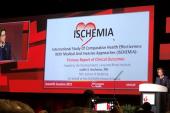Routine Functional Testing Unnecessary After Stenting: POST-PCI
The trial, though negative, provides value for physicians by demonstrating what not to do after PCI, Davide Capodanno says.

After PCI, there is no value to routine functional testing above and beyond standard care in high-risk patients, new data suggest. Doing such follow-up at 1 year had no impact on 2-year clinical outcomes.
Based on the POST-PCI trial, Duk-Woo Park, MD (Asan Medical Center, Seoul, Republic of Korea), who presented the findings recently at the European Society of Cardiology Congress 2022, said the “active surveillance with routine functional testing” is an unwarranted strategy following PCI.
The results were simultaneously published in the New England Journal of Medicine.
Davide Capodanno, MD, PhD (University of Catania, Italy), who was not involved in the study, told TCTMD in an email that he’s not surprised by the results. “The ISCHEMIA trial somehow already indirectly suggested that we should revisit our approach to ischemia testing as a trigger to revascularization and concentrate more on medical treatment,” he noted.
In an editorial accompanying the study, Jacqueline E. Tamis-Holland, MD (Icahn School of Medicine at Mount Sinai, New York, NY), also says the study “builds on the findings” from ISCHEMIA. “Collectively, these trials highlight the lack of benefit of routine stress testing in asymptomatic patients,” she writes.
Current European guidelines give a class IIb recommendation for surveillance stress testing after PCI, and the US guidelines do not give any guidance for this practice. In her editorial, Tamis-Holland argues that the POST-PCI data make the case for a future class III designation to advise that follow-up functional tests are not useful/effective.
“Until then, we must refrain from prescribing surveillance stress testing to our patients after PCI, in the absence of other clinical signs or symptoms suggestive of stent failure,” she advises.
Capodanno agreed. “A class III [recommendation] may be reasonable to avoid overreaction to ischemia findings with referral to invasive coronary angiography and placement of unnecessary stents in a situation otherwise manageable with medications,” he said.
No Differences
For the study, Park and colleagues randomized 1,706 patients (mean age 64.7 years; 80% male) with high-risk anatomical or clinical characteristics treated with PCI to undergo routine functional testing–nuclear stress testing, exercise electrocardiography, or stress echocardiography—at 1 year or receive standard care.
Overall, 21.0% of the population had left main disease, 43.5% had bifurcation disease, 69.8% had multivessel disease, 70.1% had diffuse long lesions, 38.7% had diabetes, and 96.4% had been treated with DES. Of note, about three-quarters of patients underwent PCI with IVUS, while fractional flow reserve (FFR) to assess the physiologic significance of coronary lesions was used in slightly more than one-third of patients.
At 2 years, the incidence of the primary composite outcome of all-cause death, MI, or hospitalization for unstable angina did not differ between the functional testing group and controls (5.5% vs 6.0%; HR 0.90; 95% CI 0.61-1.35). There were also no differences for the individual components of the primary outcome.
Further, a landmark analysis performed between 1 and 2 years showed a more than twofold higher incidence of coronary angiography (8.2% vs 3.3%; HR 2.57; 95% CI 1.62-4.09) and revascularization (5.8% vs 2.4%; HR 2.44; 95% CI 1.43-4.16) in the functional-testing group compared with the standard-care group. Yet, there were still no meaningful between-group differences in the rates of death or MI.
There were also no differences in the composite primary endpoint among any prespecified subgroups.
Park acknowledged that the overall incidence of events was “lower than expected in the two investigational groups, possibly due to improvements in the methods and techniques to perform complex PCI and general improvements in cardiovascular care during the past few years.” Even with that as well as their higher than usual rate of IVUS, he said the findings should be “consistent” with populations around the world.
Class III Recommendation?
Capodanno said the findings won’t change his practice, as he is “not a fan of screening with stress tests in asymptomatic subjects.” However, he continued, “it serves as a reminder that follow-up after PCI should be more focused on optimizing medical therapy and assessing changes in symptoms rather than actively looking for ischemia.”
Because many of the deaths observed in this study occurred before functional testing was performed, Tamis-Holland says stent thrombosis must be considered as a cause for at least some of these events.
“Stent thrombosis is difficult to predict and most often results from inadequate platelet blockade or technical limitations of stent placement, including stent underexpansion, malapposition, or edge dissection,” she writes. “Such abnormalities are sudden events, and most occur soon after PCI. Therefore, one would not expect a routine 1-year stress test to have any effect on this serious outcome.”
“In general,” Capodanno added, “I like strategy studies like this one, which challenge current paradigms and inertia. Cardiology is such a fast-evolving field that we cannot [take] too many things for granted. So, trials aimed at eliminating unnecessary practices are as welcome as those that try to introduce better practices.”
Yael L. Maxwell is Senior Medical Journalist for TCTMD and Section Editor of TCTMD's Fellows Forum. She served as the inaugural…
Read Full BioSources
Park D-W, Kang D-Y, Ahn J-M, et al. Routine functional testing or standard care in high-risk patients after PCI. New Engl J Med. 2022;Epub ahead of print.
Tamis-Holland JE. Surveillance stress testing “POST-PCI” — A Future Class III Recommendation? New Engl J Med. 2022;Epub ahead of print.
Disclosures
- The POST-PCI trial was funded by the CardioVascular Research Foundation and Daewoong Pharmaceutical.
- Park reports receiving grants from the CardioVascular Research Foundation and Daewoong Pharmaceutical Company.
- Tamis-Holland reports holding stocks in Pfizer that were sold in 2021.
- Capodanno reports no relevant conflicts of interest.





Comments